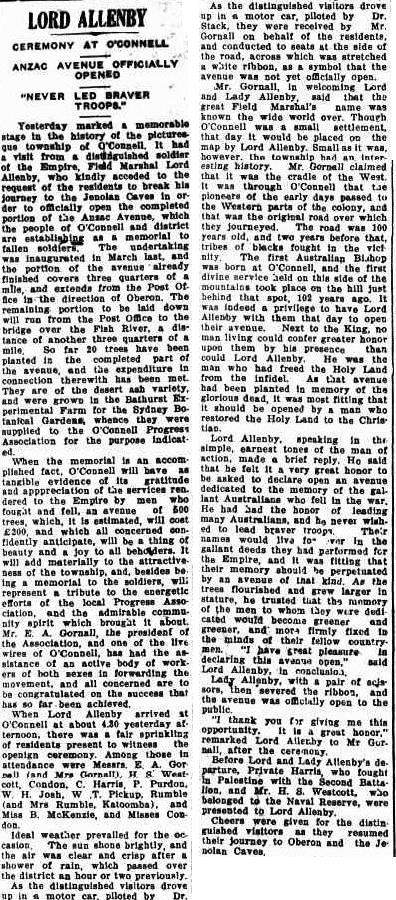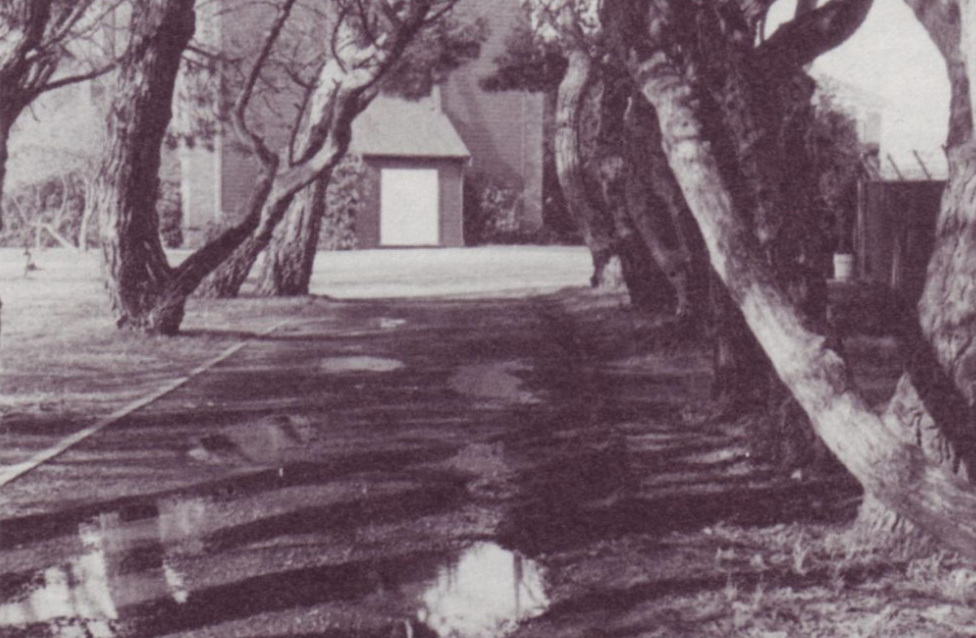Extending along O’Connell Road, from Beaconsfield Road to the O’Connell Hotel, an original double row of 123 Desert Ash trees (Fraxinus angustifolia) was established between 1926-27 to honour the WW1 service and sacrifice of local residents from the O’Connell district, south of Bathurst in NSW.
It was officially opened by Field Marshall Lord Allenby in January 1926.

LORD ALLENBY
CEREMONY AT O’CONNELL
ANZAC AVENUE OFFICIALLY OPENED
‘NEVER LED BRAVER TROOPS.’
Yesterday marked a memorable stage in the history of the picturesque township of O’Connell. It had a visit from a distinguished soldier of the Empire, Field Marshal Lord Allenby, who kindly acceded to the request of the residents to break his journey to the Jenolan Caves in order to officially open the completed portion of the Anzac Avenue, which the people of O’Connell and district are establishing as a memorial to fallen soldiers. The undertaking was inaugurated in March last, and the portion of the avenue already finished covers three quarters of a mile, and extends from the Post Office in the direction of Oberon. The remaining portion to be laid down will run from the Post Office to the bridge over the Fish River, a distance of another three quarters of a mile. So far 20 trees have been planted in the completed part of the avenue; and the expenditure in connection therewith has been met. They are of the desert ash variety, and were grown in the Bathurst Experimental Farm for the Sydney Botanical Gardens, whence they were supplied to the O’Connell Progress Association for the purpose indicated. When the memorial is an accomplished fact, O’Connell will have as tangible evidence of its gratitude and appreciation of the services rendered to the Empire by men who fought and fell, an avenue of 500 trees, which, it is estimated, will cost £200, and which all concerned confidently anticipate, will be a thing of beauty and a joy to all beholders. It will add materially to the attractiveness of the township, and, besides being a memorial to the soldiers, will represent a tribute to the energetic efforts of the local Progress Association, and the admirable community spirit which brought it about. Mr. E. A. Gornall, the president of the Association, and one of the live wires of O’Connell, has had the assistance of an active body of workers of both sexes in forwarding the movement, and all concerned are to be congratulated on the success that has so far been achieved. When Lord Allenby arrived at O’Connell at about 4.30 yesterday afternoon, there was a fair sprinkling of residents present to witness the opening ceremony. Among those in attendance were Messrs. E. A. Gornall (and Mrs. Gornall), H. S. Westcott, Condon, C. Harris, P. Purdon, W. H. Josh, W.T. Pickup, Rumble (and Mrs Rumble, Katoomba), and Miss B. McKenzie, and Misses Condon. Ideal weather prevailed for the occasion. The sun shone brightly, and the air was clear and crisp after a shower of rain, which passed over the district an hour or two previously. As the distinguished visitors drove up in a motor car, piloted by Dr. Stack, they were received by Mr. Gornall on behalf of the residents, and conducted to seats at the side of the road, across which was stretched a white ribbon, as a symbol that the avenue was not yet officially open. Mr. Gornall, in welcoming Lord and Lady Allenby, said that the great Field Marshal’s name was known the wide world over. Though O’Connell was a small settlement, that day it would be placed on the map by Lord Allenby. Small as it was, however, the township had an interesting history. Mr. Gornall claimed that it was the cradle of the West. It was through O’Connell that the pioneers of the early days passed to the Western parts of the colony, and that was the original road over which they journeyed. The road was 100 years old, and two years before that, tribes of blacks fought in the vicinity. The first Australian Bishop was born at O’Connell, and the first divine service held on this side of the mountains took place on the hill just behind that spot, 102 years ago. It was indeed a privilege to have Lord Allenby with them that day to open their avenue. Next to the King, no man living could confer greater honor upon them by his presence than could Lord Allenby. He was the man who had freed the Holy Land from the Infidel. As that avenue had been planted in memory of the glorious dead, it was most fitting that it should be opened by a man who restored the Holy Land to the Christian. Lord Allenby, speaking in the simple, earnest tones of the man of action, made a brief reply. He said that he felt it a very great honor to be asked to declare open an avenue dedicated to the memory of the gallant Australians who fell in the war. He had had the honor of leading many Australians, and he never wished to lead braver troops. Their names would live for ever in the gallant deeds they had performed for the Empire, and it was fitting that their memory should be perpetuated by an avenue of that kind. As the trees flourished and grew larger in stature, he trusted that the memory of the men to whom they were dedicated would become greener and greener, and more firmly fixed in the minds of their fellow countrymen. ” I have great pleasure in declaring this avenue open,” said Lord Allenby, in conclusion. Lady Allenby, with a pair of scissors, then severed the ribbon, and the avenue was officially open to the public. ” I thank you for giving me this opportunity. It is a great honor,” remarked Lord Allenby to Mr Gornall, after the ceremony. Before Lord and Lady Allenby’s departure, Private Harris, who fought in Palestine with the Second Battalion, and Mr. H. S. Westcott, who belonged to the Naval Reserve, were presented to Lord Allenby. Cheers were given for the distinguished visitors as they resumed their journey to Oberon and the Jenolan Caves.
National Advocate (Bathurst, NSW : 1889 – 1954), Thursday 21 January 1926, page 2
Of the sixty-six known men and women of the area who enlisted, twelve were killed in action.
The project was the initiative of the men and women of the O’Connell community. Dances and musical events were held to raise funds for the commemorative cause undertaken by the O’Connell Progress Association.
The O’Connell ANZAC Memorial Avenue is of particular historical significance, as it is one of only a few surviving First World War Memorial Avenues in rural New South Wales.
The trees were raised from seed imported from the Middle East by the Royal Botanic Gardens, Sydney, and grown at the Bathurst Experimental Farm. Desert Ash trees were chosen for their hardiness and links to World War I battle sites.
The high branches of the towering mature trees of the living war memorial connect each with each other to form an arch resembling a cathedral. This symbol of grandeur and honour is deeply significant to the community of O’Connell and district.
O’Connell ANZAC Memorial Avenue and associated buildings are listed on the National Trust Register of Australia (NSW). The Memorial Avenue is listed on the NSW War Memorials Register and has state and national recognition.
The information above is adapted from research by S. Willis, local historian from the O’Connell district.


